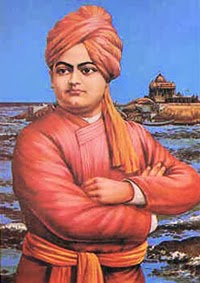renuka
Well-known member
I came across this today..word of Swami Vivekananda..View Expressed by Swami Vivekananda on Purification of Converted Hindus and Non Hindus.
What attracted my attention here is the last paragraph where it says:
I was wondering why did Swami Vivekananda suggest a Vaishnava sect and not any other sect?
And what Kalai would this new sect be called??
Full article below:
Views expressed by Swami Vivekananda about purification !
March 5, 2014
Phalgun Shuklapaksha 6, Kaliyug Varsha 5115
In 1899, a periodical called ‘Prabuddha Bharat’ had held discussions with Swami Vivekananda on converted Hindus and purification of original non-Hindus. Given below is a gist of clarifications made by Swami Vivekananda to the doubts raised by representative of ‘Prabuddha Bharat’.
A. Purification of converted Hindus is necessary
Representative (R) : Should converted be taken back in Hindu Dharma through purification ?
Swami Vivekananda (V) : Of course, purification of converted Hindus has to be done. If that is not done, population of Hindus will go on reducing. Farishta, an ancient Muslim historian says that population of Hindus was 60 crores when Muslims first came to India. Today (in 1899), it is only 20 crores. Most of the conversions were made by Muslims or Christians on the strength of sword. Today’s converted Hindus are descendents of the earlier converted Hindus; therefore, it is not right to drive them away. Those, who got converted by choice, can also be taken back in Hindu Dharma, if they so desire. Hindus who converted to other religions due to oppression need not be asked to take atonement while taking them back in Hindu Dharma.
B. Non-Hindus were accepted by Hindu Dharma, is history !
R : Those, who are originally non-Hindus, should they be purified i.e. taken as Hindus ?
V : In past, several non-Hindus have been accepted in Hindu Dharma. Many uncivilized gangs living on the border of this country have been accepted under Hindu Dharma. All Muslim foreign invaders like Shaka, Hunn, Kushan etc. have been accepted by Hindu Dharma. Such non-Hindus by blood should not be asked to take any atonement while adopting Hindu Dharma.
C. Converted Hindus can adopt their earlier caste after purification and non-Hindus can become followers of ‘Vaishnav Sect’ after adopting Hindu Dharma
R : In which caste, such purified people should be taken?
V : Those, who were converted by force, will get their earlier caste when they come back to Hindu Dharma. Those, who are adopting Hindu Dharma for the first time, will have to be given a new caste which can be under ‘Vaishnav’ Sect. Marriages can take place amongst themselves (so as to avoid ‘Varna-sankar (cross-breeds)’) They can adopt Hindu names because there is Hindu identity and ‘chaitanya’ attached to it.
-‘Prabuddha Bharat’ (April 1899)
Source : Dainik Sanatan Prabhat
What attracted my attention here is the last paragraph where it says:
C. Converted Hindus can adopt their earlier caste after purification and non-Hindus can become followers of ‘Vaishnav Sect’ after adopting Hindu Dharma
R : In which caste, such purified people should be taken?
V : Those, who were converted by force, will get their earlier caste when they come back to Hindu Dharma. Those, who are adopting Hindu Dharma for the first time, will have to be given a new caste which can be under ‘Vaishnav’ Sect. Marriages can take place amongst themselves (so as to avoid ‘Varna-sankar (cross-breeds)’) They can adopt Hindu names because there is Hindu identity and ‘chaitanya’ attached to it.-‘Prabuddha Bharat’ (April 1899)
I was wondering why did Swami Vivekananda suggest a Vaishnava sect and not any other sect?
And what Kalai would this new sect be called??
Full article below:
Views expressed by Swami Vivekananda about purification !
March 5, 2014
Phalgun Shuklapaksha 6, Kaliyug Varsha 5115

|
A. Purification of converted Hindus is necessary
Representative (R) : Should converted be taken back in Hindu Dharma through purification ?
Swami Vivekananda (V) : Of course, purification of converted Hindus has to be done. If that is not done, population of Hindus will go on reducing. Farishta, an ancient Muslim historian says that population of Hindus was 60 crores when Muslims first came to India. Today (in 1899), it is only 20 crores. Most of the conversions were made by Muslims or Christians on the strength of sword. Today’s converted Hindus are descendents of the earlier converted Hindus; therefore, it is not right to drive them away. Those, who got converted by choice, can also be taken back in Hindu Dharma, if they so desire. Hindus who converted to other religions due to oppression need not be asked to take atonement while taking them back in Hindu Dharma.
B. Non-Hindus were accepted by Hindu Dharma, is history !
R : Those, who are originally non-Hindus, should they be purified i.e. taken as Hindus ?
V : In past, several non-Hindus have been accepted in Hindu Dharma. Many uncivilized gangs living on the border of this country have been accepted under Hindu Dharma. All Muslim foreign invaders like Shaka, Hunn, Kushan etc. have been accepted by Hindu Dharma. Such non-Hindus by blood should not be asked to take any atonement while adopting Hindu Dharma.
C. Converted Hindus can adopt their earlier caste after purification and non-Hindus can become followers of ‘Vaishnav Sect’ after adopting Hindu Dharma
R : In which caste, such purified people should be taken?
V : Those, who were converted by force, will get their earlier caste when they come back to Hindu Dharma. Those, who are adopting Hindu Dharma for the first time, will have to be given a new caste which can be under ‘Vaishnav’ Sect. Marriages can take place amongst themselves (so as to avoid ‘Varna-sankar (cross-breeds)’) They can adopt Hindu names because there is Hindu identity and ‘chaitanya’ attached to it.
-‘Prabuddha Bharat’ (April 1899)
Source : Dainik Sanatan Prabhat
Last edited:
